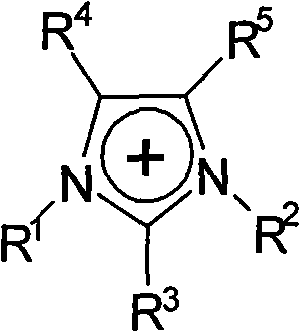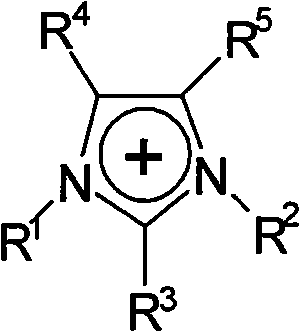Method for preparing cellulose acetate propionate or cellulose acetate butyrate
A technology of cellulose acetate propionate and acetic acid butyric acid is applied in the field of homogeneous preparation of cellulose acetate propionate or cellulose acetate butyrate mixed ester, and the effect of simple process is achieved
- Summary
- Abstract
- Description
- Claims
- Application Information
AI Technical Summary
Problems solved by technology
Method used
Image
Examples
Embodiment 1
[0034]About 0.6g of cellulose and 59.4g of ionic liquid 1-allyl-3-methylimidazolium chloride (AMIMCl) were weighed, put into a round bottom flask, heated to 60°C in an oil bath, sealed and vigorously mechanically stirred for 1 hour. A clear and transparent cellulose solution was obtained, and the concentration of the cellulose solution was 1% (mass percentage). The temperature of the oil bath was raised to 80°C, and at the same time, acetic anhydride (about 1.05ml) and propionic anhydride (about 4.75ml) were added to the solution, so that the molar ratio of acetic anhydride to cellulose glucose units was 3:1, and propionic anhydride and The molar ratio of cellulose to glucose units was 10:1, and the reaction was performed for 1 h. After the reaction is finished, methanol with 3 times the volume of the ionic liquid is added to the reaction mixture to wash the ionic liquid in the reaction mixture, filter the reaction mixture containing methanol, dry and filter the obtained solid...
Embodiment 2
[0036] About 0.6g of cellulose and 9.4g of ionic liquid 1-ethyl-3-methylimidazolium acetate (EMIMAc) were weighed, put into a round bottom flask, heated to 80°C in an oil bath, sealed and vigorously mechanically stirred for 4h. A clear and transparent cellulose solution was obtained, and the concentration of the cellulose solution was 6% (mass percentage). Raise the temperature of the oil bath to 100°C, first add acetic anhydride (about 1.74ml) to the solution so that the molar ratio of acetic anhydride to cellulose glucose unit is 5:1; add propionic anhydride (about 3.80ml) after reacting for 1 hour , so that the molar ratio of propionic anhydride to cellulose glucose unit is 8:1, continue to react for 3h. After the reaction, the post-treatment of the reaction mixture and the recovery of the ionic liquid are basically the same as in Example 1, except that ethanol with 5 times the volume of the ionic liquid is added to the reaction mixture. After testing, the acetyl substituti...
Embodiment 3
[0038] About 3g of cellulose and 12g of ionic liquid 1-butyl-3-methylimidazolium chloride (BMIMCl) were weighed, put into a round bottom flask, heated to 100°C in an oil bath, sealed and vigorously mechanically stirred for 10h. A clear and transparent cellulose solution was obtained, and the concentration of the cellulose solution was 20% (mass percentage). Raise the temperature of the oil bath to 120°C, first add propionic anhydride (about 14.25ml) to the solution so that the molar ratio of propionic anhydride to cellulose glucose unit is 6:1; after reacting for 2 hours, add acetic anhydride (about 12.25ml ), the molar ratio of acetic anhydride to cellulose glucose unit is 7:1, and the reaction is continued for 5h. After the reaction, the post-treatment of the reaction mixture and the recovery of the ionic liquid are basically the same as in Example 1, except that propanol, which is 7 times the volume of the ionic liquid, is added to the reaction mixture. After testing, the a...
PUM
| Property | Measurement | Unit |
|---|---|---|
| degree of substitution | aaaaa | aaaaa |
| degree of substitution | aaaaa | aaaaa |
| degree of substitution | aaaaa | aaaaa |
Abstract
Description
Claims
Application Information
 Login to View More
Login to View More - R&D
- Intellectual Property
- Life Sciences
- Materials
- Tech Scout
- Unparalleled Data Quality
- Higher Quality Content
- 60% Fewer Hallucinations
Browse by: Latest US Patents, China's latest patents, Technical Efficacy Thesaurus, Application Domain, Technology Topic, Popular Technical Reports.
© 2025 PatSnap. All rights reserved.Legal|Privacy policy|Modern Slavery Act Transparency Statement|Sitemap|About US| Contact US: help@patsnap.com


